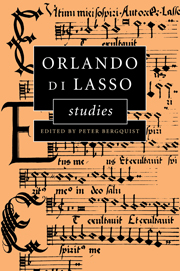Book contents
- Frontmatter
- Contents
- Preface
- List of abbreviations
- 1 Aspects of form in Orlando di Lasso's Magnificat settings
- 2 Orlando di Lasso and Andrea Gabrieli: two motets and their masses in a Munich choir book from 1564–65
- 3 Post-Tridentine liturgical change and functional music: Lasso's cycle of polyphonic Latin hymns
- 4 The salon as marketplace in the 1550s: patrons and collectors of Lasso's secular music
- 5 Lasso's “Standomi un giorno” and the canzone in the mid-sixteenth century
- 6 Lasso's “Fertur in conviviis”: on the history of its text and transmission
- 7 Orlando di Lasso and Rome: personal contacts and musical influences
- 8 Orlando di Lasso as a model for composition as seen in the three-voice motets of Jean de Castro
- 9 The madrigal book of Jean Turnhout (1589) and its relationship to Lasso
- 10 Modal ordering within Orlando di Lasso's publications
- 11 Correct and incorrect accentuation in Lasso's music: on the implied dependence on the text in classical vocal polyphony
- General index
- Index of Lasso compositions and printed sources
5 - Lasso's “Standomi un giorno” and the canzone in the mid-sixteenth century
Published online by Cambridge University Press: 18 December 2009
- Frontmatter
- Contents
- Preface
- List of abbreviations
- 1 Aspects of form in Orlando di Lasso's Magnificat settings
- 2 Orlando di Lasso and Andrea Gabrieli: two motets and their masses in a Munich choir book from 1564–65
- 3 Post-Tridentine liturgical change and functional music: Lasso's cycle of polyphonic Latin hymns
- 4 The salon as marketplace in the 1550s: patrons and collectors of Lasso's secular music
- 5 Lasso's “Standomi un giorno” and the canzone in the mid-sixteenth century
- 6 Lasso's “Fertur in conviviis”: on the history of its text and transmission
- 7 Orlando di Lasso and Rome: personal contacts and musical influences
- 8 Orlando di Lasso as a model for composition as seen in the three-voice motets of Jean de Castro
- 9 The madrigal book of Jean Turnhout (1589) and its relationship to Lasso
- 10 Modal ordering within Orlando di Lasso's publications
- 11 Correct and incorrect accentuation in Lasso's music: on the implied dependence on the text in classical vocal polyphony
- General index
- Index of Lasso compositions and printed sources
Summary
A new madrigal genre began to appear in Italian publications in the mid– 1540s, consisting of settings of entire multi-stanza poems, some with as many as fourteen strophes. The genre came to be known collectively as the canzone, although other multi-stanza poetic forms such as the sestina and ottava rima were also set. The genre had its first flourishing in the 1540s, but continued in popularity throughout the end of the century. Here I will address some of the compositional problems and solutions resulting from the composers' decision to write in such a large-scale form, concentrating on an early example of the genre by Lasso.
In 1557 Antonio Barrè published his Secondo libro delle muse, a cinque voci, madrig. d'Orlando di Lassus con una canzone del Petrarca (RISM 1557=1557b), a collection devoted for the most part to works of Lasso not previously published. Leading off the collection was Lasso's setting of the six stanzas of Petrarch's “Standomi un giorno,” a visionary poem which had been set to music in its entirety only once before. By 1557 Lasso had already been away from Rome for at least two years. His music in Barrè's anthology, while published in Rome, appears not to be directly connected to the composer's sojourn there. In the volume's dedicatory letter its signator, Giovanbattista Bruno, who styles himself “one who knows the author well,” stated that he had come into possession of the pieces by Lasso “many days ago in Spoleto.”
- Type
- Chapter
- Information
- Orlando di Lasso Studies , pp. 91 - 115Publisher: Cambridge University PressPrint publication year: 1999



